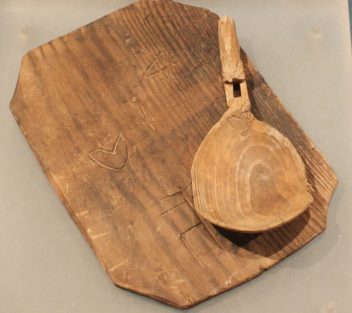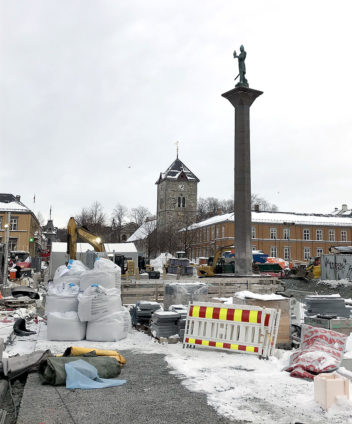Toss it if it’s 481 years old – but not if it’s a year older
Norway conserves archaeological finds from 1537, but not when they’re from 1538 or later. That means we know less about people’s everyday lives during the last 481 years.
These have been the rules since Norway set the protection limit for archaeological deposits in the country’s first cultural heritage law in 1905.
This law deemed that archaeological material originating before 1537 should be protected. Anything later was no big deal.
The date that was selected was anything but random.

A spoon and platter from the Reformation period. These were found at the Archbishop’s Palace in Trondheim, and were used by someone who worked there. They were likely owned by the same person, because they both have the same heart-shaped brand on them. Photo: Chris McLees, NIKU
The Protestant Reformation came to Norway in 1537, and with it, both the Middle Ages and a large part of the country’s self-determination disappeared. The Catholic Archbishop was key to providing a kind of balance of power between Norway and Denmark, but that soon ended when he was chased out of the country.
When the first Cultural Heritage Act was adopted as a new and independent Norway was being formed, the archaeological heritage and material history originating during Danish and Swedish rule weren’t seen as worthy of protection.
“The individuals who designed the law had a perception of the Middle Ages as Norway’s golden age,” says Christopher McLees. He recently completed his doctoral degree at NTNU with a thesis that addresses this seemingly strange protection limit.
The age limit for buried archaeological deposits hasn’t changed since the original law was passed and remains part of Norway’s current cultural heritage law. McLees believes this is a problem.
The scope of historical knowledge that we are losing is steadily widening as the material remains of the lives of previous generations are being neglected and destroyed.
- You might also like: Unique Middle Age tapestry gives insight into medieval times
People are surprised
In recent years, archaeologists have been excavating cultural layers containing newer objects and building remains at Trondheim Torg, right in the heart of the city. This is only happening because archaeologists were granted a rare exception to the rule. Normally, excavators would have free rein to go ahead with construction in the post-Reformation deposit layers here.

Archaeologists have been granted an exception to the Cultural Heritage Act in downtown Trondheim and can save objects that date from after 1537. Photo: Steinar Brandslet, NTNU
“Passers-by who hear this are surprised – and appalled,” says the new Doctor McLees, who works as an adviser and researcher at the Norwegian Institute for Cultural Heritage Research (NIKU). He has been aware of the issue for decades.
He and others have had to watch while several-hundred-year-old history was destroyed forever at construction sites. This time, archaeological finds from the 16th century and later are also being recorded. They include trash, products, tools and built objects left by craftsmen and other ordinary people who lived and worked in what were then the city outskirts before Cicignon’s reconstruction of Trondheim after the great fire of 1681.
Archaeologists from other countries are often astonished when they hear about the strict distinction, where objects from one year must be conserved, but objects from the following year are not. Denmark implements a flexible age limit, in which archaeologists argue for conservation on a case-by-case base. Sweden’s limit is currently set to 1850 and adjusted over time.
Economic reasons
The age limit for conserving cultural remains set in 1905 went beyond merely historical and national romantic reasons, and those were the economic aspects. Norway was full of objects and buildings that were several hundred years old. Not everything could be protected if room was to be made for the modern age.
“Then, just like now, society didn’t want to incur additional costs,” McLees says.
And it costs money to take care of old things. Impinging on property rights and imposing constraints on development were factors that probably also contributed to retaining the 1905 age limit.
- You might also like: Do archaeologists have to dig to uncover the mysteries of the past?
Special rules
But several other types of protection and special exceptions besides the Cultural Heritage Act exist. These include shipwrecks and cargo more than 100 years old, and all Sami cultural remains from prior to 1917. Exceptions are made for special cultural monuments and environments of more recent vintage – so they can’t simply be destroyed.
It’s quite paradoxical that standing buildings from before 1650 are automatically protected, while cellars – and sometimes the foundations of buildings that burned down or that people intentionally let fall into ruin because they were in the way of something else – are not.

Baby crib. All Sami objects older than 100 years are protected. But they are among the exceptions in Norway. Photo: Åge Hojem, NTNU University Museum
Everyday life disappearing
In the past, protection has often focused on conserving special or grand objects rather than preserving the history of the common folk. Ethnologists, historians, architects and cultural historians have dominated the decision making in terms of what to conserve. They have often prioritized and valued written, aesthetic and visible sources more highly as sources of knowledge about our recent past.
“Archaeology and the invisible buried material remains of daily life have ended up low on the list of priorities,” McLees says.
Archaeologists are interested in more than impressive churches, the king’s gold or flashy buildings. They want to uncover the history hidden underground and how ordinary people like you and me actually lived in the past – the kinds of clothes they wore, what they ate, the tools they used, and the things that occupied them in their daily lives. In this context, a cooking pot or a shoe can tell just as exciting a story as a gold ring or a beautifully painted portrait.
“This is also a part of history that people today can relate to,” McLees says.
Often, it’s probably easier to understand conserving a striking mansion than the buried ruins of buildings and backyards in parts of the city where people on the lower rungs of society lived and died. But what would tell future archaeologists most about your everyday life – your mobile phone or a Picasso painting?

A clay pipe — called a Jonas pipe — from the 1600s. Photo: Norwegian Directorate for Cultural Heritage
- You might also like: Viking house remains found along planned E6 road route
Protections changing – for some things
Internationally, cultural heritage agencies have long been aware of the need to conserve the material history of our most recent past. Norway is also undergoing an awakening in the academic and management realms of heritage protection, and post-Reformation archaeology is gaining greater significance.
The Norwegian Directorate for Cultural Heritage has prioritized ten themes in recent history and plans to protect important cultural monuments within each of them. The conservation strategy includes defence and war history, industry, old traffic routes and particularly important post-1537 archaeological sites, including cultural layers in cities and towns. Separate rules have been established for national minorities, such as the Kven and Roma peoples, who are entitled to extra protection of their past.
“The Directorate for Cultural Heritage’s proposal is at least in part a delayed response to the fact that the Norwegian authorities have actually committed to conserving more of our cultural heritage through the European Malta Convention,” McLees said.
Hermetically sealed
Although McLees welcomes this much delayed measure, he is not optimistic about the effectiveness of the conservation strategy or the future management of Norway’s recent archaeological heritage.
“The criteria for selecting the objects for permanent protection haven’t been specified. This form of protection will put a hermetic lid on the selected cultural monuments. They’ll continue to gradually deteriorate, and won’t be able to be used as sources for research or historical writing,” he says.
The 1537 age limit will also stand in most cases, and the remaining material sources of the past 500 years of history will continue to disappear and be neglected.
McLees believes the stories written about our near future will still have gaps and be inadequate.
“They’ll leave out what has always been indispensable in the lives of human beings through the ages – material objects.
Source: McLees, Christopher. Materialities of Modernity and Social Practice in Trondheim c.1500-1800: An Archaeological Contribution to the Study of Post-Medieval Norway.






